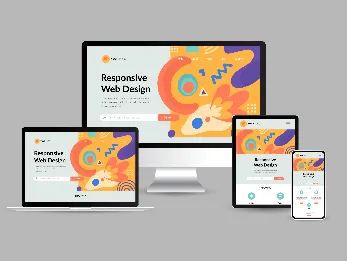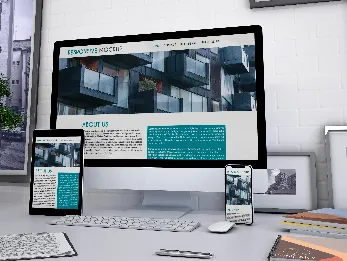Top Website Design for Real Estates That You Must Know
6 mins | 28 Nov 2023

Imagine your real estate website as a friendly guide, not just a fancy online signboard. It's like the front door to your world, where people can peek into their future homes. Whether you've been doing this for ages or you're just getting started, your website is your digital handshake, inviting folks to explore the homes and dreams you have to offer. Let's take a stroll together through the world of real estate website design, where simple steps make your online space feel like a cozy home for potential clients.
In the era of advanced technology, incorporating virtual tours and 3D walkthroughs can elevate the user experience on your real estate website. Potential buyers appreciate the ability to explore a property from the comfort of their homes. Use keywords like property selling websites and real estate websites to optimize your content and attract users searching for immersive experiences. Ensure that these features are mobile-friendly, enabling users to access virtual tours on various devices seamlessly.

1) Mobile Responsiveness: A Cornerstone of Accessibility
In the contemporary real estate landscape, where mobility is paramount, the responsiveness of a website to diverse devices is foundational. Picture a potential homebuyer navigating property listings during a routine coffee break. Mobile responsiveness is more than a design element; it's an assurance of accessibility. The website must adapt flawlessly to various screen sizes, providing an optimal viewing experience on smartphones and tablets. Integration of keywords such as 'real estate website' and 'real estate site design' into mobile content is imperative for visibility and engagement on these compact screens.
Integrating maps into your website is a game-changer for real estate. Displaying property locations provides valuable context for potential buyers. Interactive maps allow users to explore neighborhoods, nearby amenities, and points of interest. Consider integrating both map and list views to cater to different user preferences.
Users can explore the neighborhoods where properties are situated. Interactive maps can display nearby schools, parks, shopping centers, public transportation, and other amenities.
Highlighting local attractions and facilities on the map enhances the overall user experience and helps potential buyers make more informed decisions.

2) Dynamic Offers Display:
Implement a section on the real estate website dedicated to showcasing dynamic offers and promotions. This could include limited-time discounts, special financing options, or exclusive deals on selected properties. Ensure that the offers are visually appealing and strategically placed on the website to capture the attention of potential buyers.
3) Special Collaborations:
Establish smart collaborations with furniture stores to enhance the overall home-buying experience. Work with selected furniture partners to offer special discounts or exclusive packages for users who purchase a property through your website.
Integrate links or redirect functionalities to seamlessly transition users from the real estate site to partner furniture stores, creating a cohesive journey from property selection to furnishing.
4) Social Media Integration: Establishing a Personal Connection
Beyond being a repository for property listings, a real estate website should transcend its utilitarian purpose. Social media integration becomes a conduit for establishing a personal connection with the audience. Visualize a platform where not only properties are showcased but also the stories that breathe life into them. Platforms like Facebook, Instagram, and Twitter evolve into storytelling canvases, enriching the narrative. The strategic use of keywords like 'real estate website design' and 'websites for real estate' in social media posts contributes not only to discoverability but also to becoming an integral part of the broader social discourse.

5) User-Friendly Navigation: Guiding Through Complexity
Navigating the intricacies of real estate can be a daunting task for clients. Consider the website as a virtual guide, simplifying the journey toward finding one's dream home. Intuitive menus and filters become markers, streamlining property searches and ensuring that users effortlessly access information on property types, locations, and amenities. The incorporation of keywords such as 'real estate design website' and 'real estate homepage design' into navigation labels adds a professional touch to the user experience, making the journey memorable and efficient.
6) Client Testimonials: Anchoring Trust in the Virtual Space
In the ethereal domain of the internet, establishing trust takes center stage. Client testimonials emerge as testimonials not just in text but as vocal affirmations within the digital realm. Encouraging clients to authentically share their experiences while seamlessly integrating keywords like 'website design for realtors' and 'designing a real estate website' fortifies the foundation of trust. Testimonials transcend mere statements; they form the pillars of confidence, assuring potential clients that they are entering into a partnership with a reputable real estate service.

7) Regular Content Updates: Sustaining Relevance in Dynamic Markets
Real estate markets are dynamic ecosystems, necessitating websites that mirror this dynamism. Regular updates extend beyond mere compliance with search engine algorithms; they represent an ongoing dialogue with the audience. Envision the website as a living entity, disseminating blog posts, market insights, and tips for buyers and sellers. Strategic deployment of keywords such as 'real estate website design agency' and 'websites for real estate' ensures not just visibility but engagement with users seeking the latest developments in the real estate sector. The commitment lies not just in staying relevant but in serving as a dependable source in an ever-evolving market.
8) Clear Call-to-Action (CTA): Inviting Strategic Engagement
Every webpage on the real estate website serves as an invitation, urging visitors to take purposeful action. Whether it involves scheduling a property viewing, soliciting additional information, or subscribing to newsletters, the clarity and efficacy of Calls-to-Action (CTAs) are paramount. The strategic inclusion of keywords like 'web design for real estate' and 'real estate website design' in CTAs reinforces the website's purpose, enhancing search engine visibility and inviting users to embark on the next chapter of their real estate journey.
The optimization of real estate website design is a multifaceted endeavor, blending technological acumen with a human-centric approach. Each component, from mobile responsiveness to social media integration, user-friendly navigation, client testimonials, regular content updates, and clear CTAs, contributes to the creation of a sophisticated and trustworthy online platform. In the realm of real estate, where precision and reliability are non-negotiable, a meticulously designed website becomes a testament to professionalism and client-focused engagement.
Conclusion:
Remember, your website is often the first interaction potential clients have with your real estate services. Make that first impression count by providing a seamless, informative, and engaging online experience. Continuously adapt and optimize your website to stay ahead in the ever-evolving real estate industry. With a well-designed and strategically crafted website, you can attract, engage, and convert visitors into satisfied clients, ultimately contributing to the growth and success of your real estate business.
As we wrap up our chat about real estate website design, think of your website like a good neighbor – not distant and cold, but warm and ready to help. It's not just a bunch of computer stuff; it's a conversation starter, a helping hand, making the sometimes tricky process of buying or selling a home a bit easier. So, as you navigate the world of real estate, let your website be that friendly door, always open and ready to guide folks through the exciting journey of finding a new place to call home. It's not just about techy things; it's about creating a comfy space where dreams and real estate meet.
Author

Share
Share
Related

Polymers, Innovation, And A Modern Website: The Goldstab Organics Journey
5 mins : 10 Nov 2025

From Friction to Finish Line: The God of Sports Digital Transformation
6 mins : 17 Sept 2025

The Future Of Responsive Web Design: Emerging Trends, Innovations And Predictions In 2024
7 mins : 26 Apr 2024
Other Articles

Responsive Web Design: Understanding The Basics For Seamless User Experiences
7 mins : 29 Apr 2024

Everything You Should Know About The Ideal Screen Size For Responsive Design
6 mins : 26 Apr 2024

Enhance Your Web Design Creativity with Google Web Designer
4 mins : 17 Nov 2023
